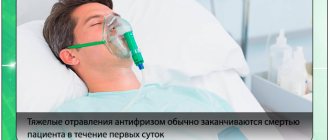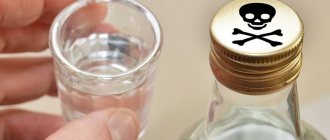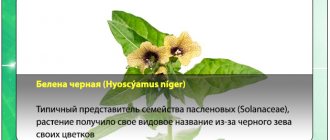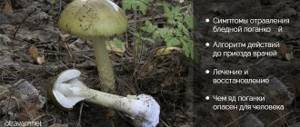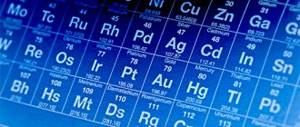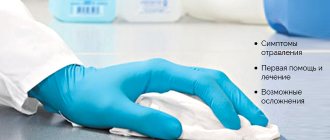Acetic acid, when exposed to the human body, has a local cauterizing and general toxic effect on the blood (destruction of red blood cells - hemolysis), kidneys, and liver.
Table vinegar (3-6-9%) is often used in everyday life for cooking, for pickling, baking, descaling teapots, etc. Strong acetic acid (70-80%), or essence, is used for the same purpose, first diluting it with water to obtain the desired concentration.
Acetic acid is a colorless liquid with a characteristic pungent odor and sour taste. Hygroscopic, unlimitedly soluble in water. Miscible with many solvents. Accidental ingestion of vinegar is very difficult due to the strong odor of this acid and the immediate irritant effect on the respiratory tract. However, such cases occur with sad consistency, and most often in persons suffering from alcoholism. The second option for using vinegar essence is a person’s suicidal intentions, when vinegar poisoning occurs deliberately.
The toxic properties of acetic acid do not depend on the method by which it was obtained. The effect on living tissue is determined by the concentration of the acid solution. The greatest danger in case of poisoning is acid with a strength of 30% or more. The lethal dose is approximately 20 ml.
Causes of acetic acid poisoning
Intoxication with acetic acid occurs when liquid penetrates the digestive tract, as well as from inhaling vinegar vapor. As a result of human exposure to acetic acid vapor, poisoning occurs both at home and at work.
In everyday life, the cause of poisoning is carelessness when diluting the essence, as well as the use of large quantities of this solution to clean certain surfaces in an unventilated room. In production, inhalation of these vapors occurs when safety precautions are violated.
Causes of poisoning with acetic acid and essence:
- Unintentional consumption of hazardous liquid . Most often this happens to small children who taste everything. Accidental consumption of vinegar can also occur in alcoholics during abstinence;
- Using vinegar for the purpose of suicide. Teenagers and women often decide to commit suicide using this method. Drinking vinegar does indeed lead to death, however, not always. Often a person remains disabled or dies for a long time and painfully.
What detergents can cause poisoning?
Modern detergents make human life easier. Contact with radical chemicals requires the implementation of a number of strict recommendations. Common substances in demand in everyday life are:
- Surfactants.
- High-quality oxidizing agents containing oxygen/chlorine spectrum bleach.
- Hydrocarbon type structures.
- Alkaline structures that remove blockages in pipes.
- Acetic acid and various alcohols.
Poisoning by household chemical vapors (ICD code 10 and PMPA) occurs during dry cleaning of clothing and metal products. Once in the digestive system, the substances form serious burns, gag reflexes, disorders in the neurological segment and classic hepatitis. Taking deep breaths can cause hallucinations, disruption of breathing reflexes, and death.
Symptoms of intoxication
If you drink acetic acid or essence, damage to the gastrointestinal tract and changes in the properties of the blood occur. The clinical picture of vinegar intoxication is quite specific.
The following symptoms appear:
- Sharp and intense pain in the mouth, throat, esophagus and stomach;
- Breathing is difficult, shortness of breath is observed, air is exhaled with a whistle;
- Hoarseness or complete loss of voice is associated with damage to the vocal cords;
- Vomit. The vomit contains blood and its clots, they have a characteristic odor;
- Swallowing dysfunction;
- There is blood in the stool . The stool may also turn black. All this indicates the presence of intestinal bleeding at different levels;
- Smell of vinegar from the victim, severe salivation;
- Blood pressure is sharply reduced . And in a state of shock it can decrease to critical levels;
- The pulse becomes rapid (tachycardia);
- Loss of consciousness, respiratory and cardiac arrest in shock.
The severity of the patient's condition depends on the concentration and amount of vinegar drunk.
There are 3 degrees of severity:
- The first (mild) . Marked by a chemical burn of the mucous membrane of the oral cavity, pharynx and esophagus, as well as pain. In this case, there are no severe consequences or deaths;
- Second (middle) . A burn to the gastric mucosa, which leads to disruption of the integrity of its surface and the formation of bleeding ulcers. Acetic acid penetrates the bloodstream and changes the composition and properties of the blood. It thickens, its acid-base balance changes to the acidic side (acidosis), and red blood cells are destroyed. The color of urine changes. There is a disturbance of consciousness;
- Third (heavy) . Sharp, unbearable pain along the esophagus and in the epigastrium. Severe vomiting of blood. Discoloration of urine in red, scarlet color. Painful shock (severe hypotension, tachycardia) is noted. Without timely help and treatment, death.
This is useful to know!
Possible symptoms of acetic acid vapor poisoning
:
- Sore throat;
- Cough;
- Watery eyes and runny nose;
- Redness of the eyes;
- Chest pain;
- Dyspnea;
- Inflammation of the trachea and bronchi (tracheobronchitis).
Possible complications
The consequences of exposure to toxins can be complications:
- Edema of the lungs, brain, larynx.
- Decreased central nervous system functions.
- Hypotension (severe decrease in blood pressure).
- Cardiac arrhythmia.
- Tissue hypoxia.
- Acute form of renal or liver failure.
- Violation of the water-electrolyte balance of the blood.
Poisoning with chemical substances is characterized as a dangerous condition for the victim and ignored symptoms can lead to disability. It is necessary to provide first aid in time, call a doctor and begin to treat intoxication.
News MirTesen
First aid for poisoning
In case of acetic acid poisoning, emergency assistance must be provided. Any delay and incorrect actions will only worsen the patient’s condition.
First aid for vinegar poisoning:
- If the person is conscious , then let him rinse his mouth with clean water at room temperature;
- After the mouth is cleaned, you can give a little milk or rice water to drink;
- If a person is unconscious, then lay him on his side so that he does not choke on vomit. Check pulse and breathing. In their absence, carry out resuscitation measures (indirect cardiac massage and artificial respiration);
- Apply cold to the epigastric area and along the esophagus. This will help reduce pain;
- Giving small pieces of ice to eat will also reduce pain;
- If possible, you can administer Analgin intramuscularly;
- Wait for the doctors to arrive with the victim, do not leave him alone.
If you are poisoned by vinegar, you should never do the following:
- Rinse the stomach using the restaurant method;
- Artificially induce vomiting (give emetics);
- Drink plenty of liquid. And especially with soda solution. The reaction of baking soda and vinegar is violent and will only make the situation worse.
Cleansing of the body is carried out in a hospital setting by qualified personnel:
- Gastric lavage is carried out using a gastric tube with a large amount of clean water (about 10 liters). This procedure is carried out in the absence of signs of perforation of the stomach wall (formation of a through hole in the stomach wall);
- Forced diuresis (intravenous administration of alkaline and anti-shock solutions and the use of diuretics);
- Hemodialysis is carried out in the event of acute renal failure with changes in blood parameters (an increase in potassium, creatinine and urea).
Consequences of vinegar poisoning
The most dangerous are the first 2 days after poisoning. It is during this period of time that a high mortality rate among patients is observed.
Early consequences of vinegar poisoning are:
- Massive gastrointestinal bleeding. They occur both immediately after vinegar enters the digestive tract, and in the first few days after;
- Perforation of the walls of the esophagus and stomach. This complication occurs when poisoned with high concentrations of vinegar. In this case, the contents of the esophagus and stomach enter the mediastinum and abdominal cavity. This causes inflammation of neighboring organs;
- Aspiration pneumonia. Inflammation of the lungs occurs due to the penetration of vomit into the respiratory tract.
Late consequences include:
- Infectious and inflammatory process of burned surfaces;
- Chronic gastritis – inflammation of the stomach with a chronic course;
- Esophageal strictures – cicatricial narrowing of the esophagus;
- Cicatricial change in various parts of the stomach;
- Post-burn asthenia. A person experiences a sharp decrease in weight, which is associated with disruption of digestive and metabolic processes in the body.
Short description
Poisoning (intoxication) is a pathological condition that occurs when the body is exposed to a chemical compound (poison) that causes disruption of vital functions and creates a danger to life.
Code according to the international classification of diseases ICD-10:
- T36 Systemic antibiotic poisoning
- T50 Poisoning by diuretics and other unspecified drugs, medicinal products and biological substances
- T51 Toxic effects of alcohol
- T65 Toxic effects of other and unspecified substances
Frequency • In recent years, especially in Russia, there has been a constant increase in the number of household poisonings. In addition, criminal acute poisonings are recorded more often • Acute poisonings - 200-300 people (3-5% of all patients) per 100,000 population per year (for comparison, MI - 70-80 per 100,000) • Every fifth patient with poisoning ends up in hospital in critical condition • Accidental poisonings account for about 80%, suicide - 18%, occupational - 2% of poisonings •• Currently, an average of about 120 non-fatal and 13 fatal suicidal poisonings per 100,000 inhabitants per year are recorded worldwide •• Mental illnesses - the cause of 10–15% of suicidal poisonings • Predominant age •• 13–35 years •• In Western Europe and the USA, about 50% of poisonings occur in children (in Russia - no more than 8%). The main reason is taking drugs • Predominant gender •• Suicidal poisoning - female •• Accidental household poisoning (especially alcohol and drug intoxication) - male. Etiology. There are over 500 toxic substances that cause the largest number of acute poisonings. Risk factors • Alcoholism, substance abuse, drug addiction • Frequent stress, unfavorable family environment, material and domestic problems • The tension of modern living conditions, causing in some people the need to constantly take sedatives • Mental illness • Poorly controlled sale of drugs, uncivilized advertising • Self-medication, turning to various kinds of healers, charlatans, out-of-hospital termination of pregnancy • Occupational hazards (chronic poisoning) • Improper storage of drugs and chemicals at home (more often leads to poisoning in children).
Classifications of poisoning • Depending on the cause and place of occurrence •• Accidental ••• Industrial ••• Household: self-medication, drug overdose, alcohol and drug intoxication, carbon monoxide, mushroom poisoning (pale toadstool, fly agarics, etc.), reptile bites, insects ••• Medical errors •• Intentional ••• Criminal ••• Suicidal. • Poisonings can be single, group (often family), multiple, mass (CAB, industrial poisoning). • Depending on the method of entry of poison into the body •• Oral (usually household) •• Inhalation •• Percutaneous (injections, snake and insect bites) •• Cavitary poisoning (poison entering the rectum, vagina, external auditory canal).
• According to the clinical picture •• Acute poisoning occurs with a single intake of poison into the body and is characterized by a sharp onset and pronounced specific symptoms •• Chronic poisoning develops with prolonged, often intermittent intake of poisons in subtoxic doses •• Subacute poisoning (with a single injection of poison into the body clinical the development of poisoning is slow) is rarely observed. • Depending on the severity •• Light •• Moderate •• Heavy •• Extremely severe.
Symptoms of burns with acetic acid, essence and assistance with injury
When acetic acid or essence interacts with the skin and mucous membranes, a chemical burn occurs. Symptoms of a burn directly depend on its severity.
There are 4 degrees of violation of the integrity of the skin.
| Burn severity | Depth of skin lesion | Burn symptoms |
| First (easy) | Upper layer of the epidermis |
|
| Second (middle) | Destruction of the epithelial and germ layers of the skin | Symptoms are the same as in the first degree, which is accompanied by the formation of blisters filled with serous fluid (transparent). |
| Third (heavy) | Epidermis and dermis (subcutaneous layer) are affected | Deep wound with the formation of a dark scab. The blisters burst and form an open wound surface. |
| Fourth (extremely difficult) | Damage to the skin down to the fatty tissue | Open bleeding wound. Severe pain and severe swelling of adjacent soft tissues. Areas of necrosis (dead tissue) are identified. |
In case of a vinegar burn, the following measures must be taken::
- If this dangerous liquid gets on your clothing, remove it immediately;
- Rinse the skin or mucous membranes with running or boiled water. The duration of rinsing is about 20 minutes with low water pressure;
- Repeated rinsing with soap or soda solution;
- Apply a cold compress;
- If the skin is deeply damaged and blisters form, seek medical attention immediately.
To treat a burn with acetic acid (essence), use special solutions and ointments as prescribed by a doctor:
- Chlorhexidine;
- Panthenol;
- Levomekol;
- Bepanten.
Ointments with an analgesic effect are also used.
Victor Systemov – expert of the 1Travmpunkt website
Based on the pathogenesis of this poisoning with acetic acid (essence)
, the key moments of this disease, in addition to pain shock and nonspecific sympathoadrenal reaction, are hemolysis of erythrocytes and the subsequent formation of hematin hydrochloride crystals in the acidic renal environment. These pathological processes can be interrupted. Rapid intravenous injection of hypertonic glucose solutions (10-20%) allows you to stop hemolysis and even bring back to life some of the swollen but not yet destroyed red blood cells, and intravenous injection of 4% sodium bicarbonate solution, until a persistent alkaline urine reaction is obtained, allows you to stop formation of hematin hydrochloride crystals.
Emergency aid (first aid) for acetic acid poisoning.
Prehospital stage of treatment for acetic acid poisoning
. Thorough, repeated rinsing of the mouth with water without swallowing water, then rinsing the stomach through a tube with cold water (8-10 liters) until the rinsing water is clean. The presence of blood in the washing water is not a contraindication for further washing. In the first hours after UE poisoning, there is usually no chemical damage to the large vessels of the stomach and, accordingly, there is no serious bleeding requiring emergency surgical intervention. In case of poisoning with cauterizing liquids, it is not recommended to lavage the stomach using the “restaurant” method, when the victim himself or someone assisting him causes irritation of the root of the tongue with his fingers.
It is unacceptable to rinse the stomach with soda to neutralize vinegar essence.
, because this can cause acute dilatation of the stomach!
The dangers of acetic acid
The population does not have a clear understanding of the difference between vinegar essences and acids. Differences in concentration: essence has a concentration of 70%, and acid - 6-9%. For a fatal outcome, a person only needs to take 12-15 ml of concentrate or 200 ml of acid. For a child, the lethal dose is less (5-7 ml). When purchasing vinegar with a higher concentration, it is worth diluting it with water in a ratio of 1:20 and storing the solution in this form.
The danger of acetic acid for children and adults is that inhaling the vapors of the substance is harmful to the upper respiratory tract and can cause burns. Such poisoning occurs in industrial conditions when safety precautions are violated. Acetic acid burns have a high mortality rate in moderate to severe cases, and if the victim manages to survive, there is a high probability of remaining disabled and in constant pain for the rest of his life.
Preventive actions
To avoid having to wonder what to do if you drank vinegar, you should take preventive measures in advance. You can’t keep vinegar essence at home; it’s easier to dilute it immediately after purchasing it. An even more convenient option is to buy ready-made table vinegar. Do not use expired product.
It is advisable to keep dangerous solutions and essences in places where children cannot reach them. This could be a top shelf or a cabinet that can be locked with a key. It is best to mark the bottle with a bright label that says “poison.” When preparing preserves and marinade, you must strictly adhere to the proportions specified in the recipe.
Acetic acid is a dangerous substance that can cause serious harm to health and cause irreversible changes. To avoid such disastrous consequences, it is necessary to take precautions and also learn the rules of first aid for people poisoned by vinegar.
Severity
The clinical picture of a burn of internal organs with vinegar depends on the severity of the damage and is as follows:
- A mild burn does not have serious consequences for the body. Treatment is symptomatic, local. Minor damage to the mucous membrane of the mouth and esophagus occurs.
- Moderate poisoning means serious injury. The esophagus and stomach suffer most. Internal bleeding occurs, the acid-base balance in the tissues changes towards acidification, and the blood coagulates and thickens at the site of organ damage. The body becomes dehydrated and the load on the human cardiovascular system increases.
- A severe degree is characterized by the rapid development of renal failure, blockage of blood vessels due to blood thickening, black vomiting, and the presence of red traces in the urine. The injury is comparable to 30 percent of human skin burns.
First aid for poisoning
The algorithm of action when a victim of vinegar ingestion is detected includes: immediately calling an ambulance. Further pre-medical procedures are carried out according to the following principle:
| Can | It is forbidden |
|
|
First aid for vinegar poisoning should be provided by physicians no later than 2 hours after oral administration, since the pathogenesis of the disease is rapid. Timely emergency procedures to rid the stomach of toxins, stabilize blood pressure and relieve acute sensations will prevent the victim from dying from painful, hypovolemic or hemorrhagic shock.
Further treatment
The first thing doctors do when they arrive at the scene of an accident is to rinse the stomach with saline solution using a medical probe so as not to re-injure the walls of the esophagus, and relieve pain with intravenous medications. This occurs before the patient enters a medical facility. Further medical care in a hospital setting is provided in the intensive care unit. Treatment for poisoning is aimed at:
- removal of intoxication;
- plasma infusion;
- restoration of the body's water balance;
- blood thinning;
- reduction of the inflammatory process;
- pain relief;
- alkalization of blood;
- preventing narrowing of the esophagus and its bougienage;
- maintaining the functioning of the patient’s internal organs.
In the final stages of recovery, the patient undergoes therapy to remove scar tissue from the esophagus and restore its elasticity, but the victim still will not be able to return to normal life. Throughout his life, the patient will experience pain in internal organs and eating disorders, which will have a negative impact on his quality of life.
Possible consequences
Most often, burns from drinking 9 percent table wine or apple cider vinegar occur in the kitchen, since this is one of the most accessible preservatives and leavening agents. An overdose of the substance is possible when eating homemade canned foods. The cause of injury is carelessness or improper storage.
Children can drink vinegar, due to their age, they have the habit of tasting everything. But injury from a vinegar burn is one of those that is easier to prevent than to treat. The consequences of poisoning will be:
- cicatricial changes in the walls of the stomach and esophagus;
- narrowing of the esophagus and its obstruction;
- disturbances of the acid-base balance in the body;
- disturbances of protein metabolism with severe post-burn asthenia;
- weight loss;
- chronic gastritis, belching, bad breath;
- involuntary vomiting;
- the likelihood of developing cancer.
Doctors' recommendations will help the poisoned person live as before, but after treatment, annual diagnostics in clinics will be required to avoid complications.
ICD-10, X40-X49, accidental poisoning and exposure to toxic substances
More details about the ICD-10 classifier
Date of placement in the database 03/22/2010
Relevance of the classifier: 10th revision of the International Classification of Diseases
Showing 10 entries
Home → EXTERNAL CAUSES OF MORTALITY AND MORTALITY → OTHER EXTERNAL CAUSES OF INJURIES IN ACCIDENTS → ACCIDENTAL POISONING AND EXPOSURE TO TOXIC SUBSTANCES Code Name
| X40 | Accidental poisoning and exposure to non-opioid analgesics, antipyretics and antirheumatic drugs |
| X41 | Accidental poisoning and exposure to anticonvulsants, sedatives, hypnotics, antiparkinsonian and psychotropic drugs, not classified elsewhere |
| X42 | Accidental poisoning and exposure to drugs and psychodysleptics [hallucinogens], not elsewhere classified |
| X43 | Accidental poisoning and exposure to other drugs affecting the autonomic nervous system |
| X44 | Accidental poisoning and exposure to other and unspecified drugs, medications and biological substances |
| X45 | Accidental poisoning and exposure to alcohol |
| X46 | Accidental poisoning and exposure to organic solvents, halogenated hydrocarbons and their vapors |
| X47 | Accidental poisoning and exposure to other gases and vapors |
| X48 | Accidental poisoning and exposure to pesticides |
| X49 | Accidental poisoning and exposure to other and unspecified chemicals and toxic substances |
www.classbase.ru




